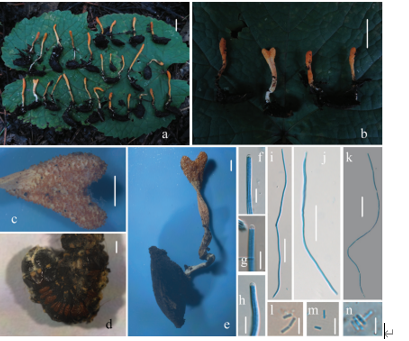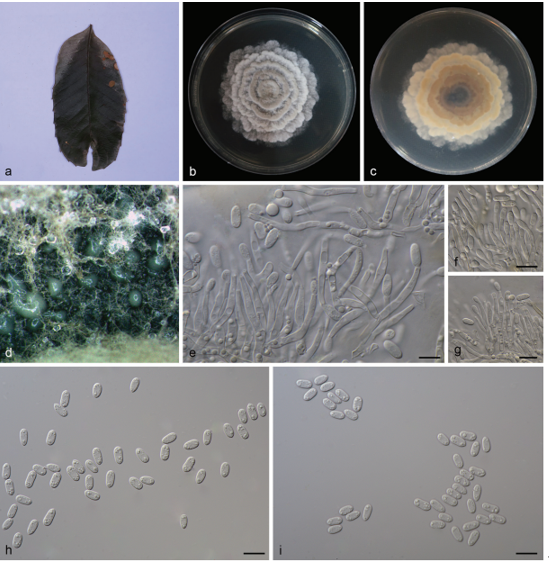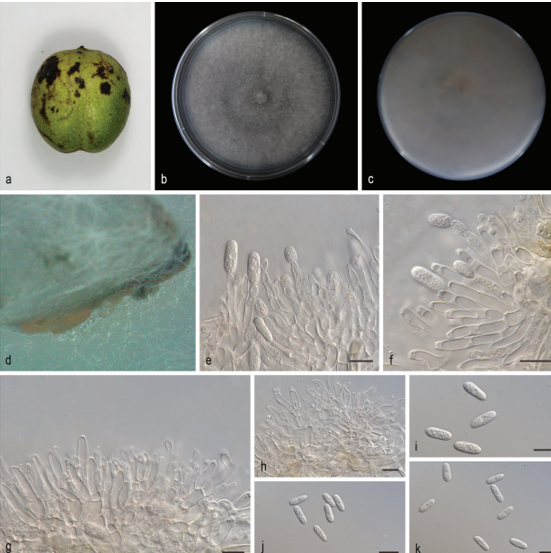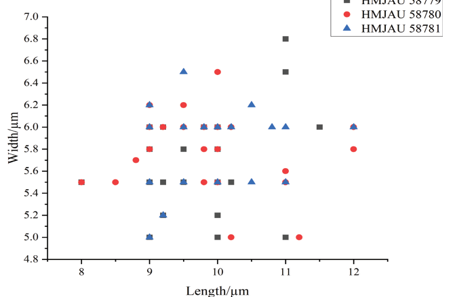Apiculospora penniseti A. Karunarathna & C.H. Kuo, sp. nov.2021
Index Fungorum Number: IF557871, Facesoffungi number: FoF 09221
Holotype: Saprobic on dried leaves of Pennisetum purpureum.
Morphological description
Undetermined. Asexual morph: Conidiomata 100–160μm high × 70–125μm diam. ( x = 127 × 90μm, n = 5), pycnidial, immersed to erumpent, unilocular, sub-globose, dark brown, spore masses are spread across the host surface immediately above the conidiomata at the maturity. Spore mass tightly attached to the host surface. Conidiomata wall 13–16μm, outer layer, composed of thin-walled, brown cells of textura angularis; inner layer thin-walled, almost reduced to conidiogenesis region. Conidiophores reduced to conidiogenous cells. Paraphyses 1–2µm wide, among conidiogenous cells, light brown, smooth, septate, cylindrical, branched. Conidiogenous cells 5–10 × 2–3μm ( x = 7 × 2μm, n = 20), subcylindrical to ovoid, enteroblastic, phialidic with percurrent proliferation, discrete, indeterminate, hyaline, smooth-walled. Conidia 15–20 × 5–8 μm ( x = 17 × 7 μm, n = 20), ellipsoid to subcylindrical, straight to slightly curved, base truncate, both apices with clear apiculi, 1-septate, pale brown to dark brown and notable dark brown region at the septum, guttulate, thick and smooth-walled.
Habitat: On decaying stems of Pennisetum purpureum Schumach. (Poaceae)
Distribution: CHINA, Taiwan region, Chiayi Province, Kwang Hwa.
GenBank Accession: ITS MT937251; LSU MT937250.
Notes: Apiculospora was introduced by Wijayawardene et al. (2016) in Helotiales, genera incertae sedis. Ekanayaka et al. (2019) transferred Apiculospora to Leotiomycetes genera incertae sedis based on multigene phylogeny. Pezizellaceae contains the coelomycetous genus, Porodiplodia (Crous et al. 2018). Porodiplodia contains conidia with fusoid-ellipsoid to sub cylindrical, medium brown, finely verruculose, guttulate, thick-walled, 1-septate and prominently conidia with obtuse apex (at times with central pore) and truncate base. While, Apiculospora consists the spores with ellipsoid to sub cylindrical, pale brown to dark brown, guttulate, thick to smooth walled, 1-septate and with prominent apicules at the both apices and truncate base (Crous et al. 2018). Further our species Apiculospora penniseti contains paraphyces and Porodiplodia also contains paraphyces. Hence, by considering the taxonomy (Table 2) and phylogeny (FIGURE 1) of Porodiplodia and Apiculospora, we transfer Apiculospora to Pezizellaceae. The generic description for the Apiculospora and type description along with illustrations were provided in Wijayawardene et al.(2016).
Reference: Karunarathna, A. , Dziaak, P. , Jayawardena, R. S. , Karunarathna, S. C. , & Lumyong, S. . (2021). A novel addition to the pezizellaceae (rhytismatales, ascomycota). Phytotaxa, 480(3), 251-261.
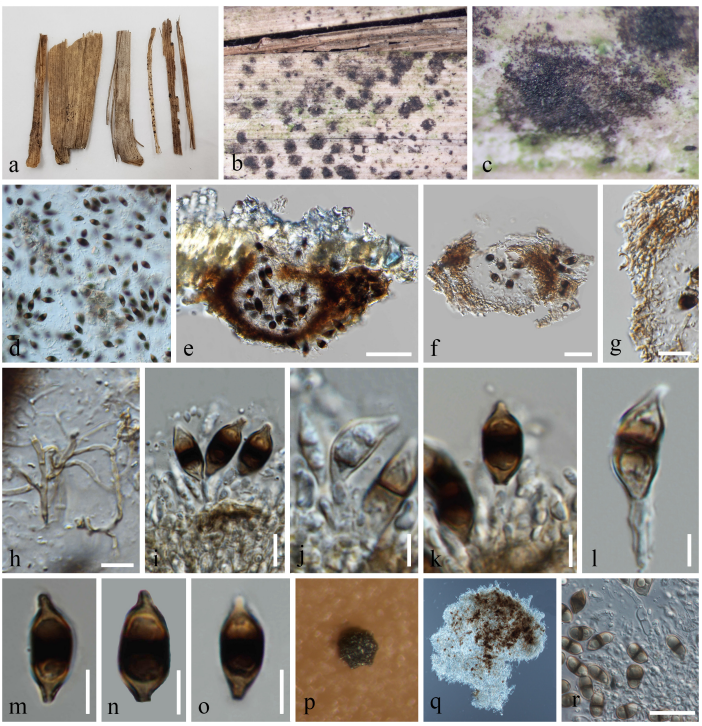 Apiculospora penniseti (MFLU 20-0543, holotype). a,b Appearance of conidiomata on host surface. c,d Conidia on the surface of the host. e,f Section through conidioma. g Pycnidial wall. h Paraphyses. i-l Conidiogenous cells with conidia. m-o Conidia. p,q Conidiomata on the culture. r Conidia from the culture. Scale bars: e = 20 µm g,i,r = 10 µm f = 50 µm h,j–o = 5 µm.
Apiculospora penniseti (MFLU 20-0543, holotype). a,b Appearance of conidiomata on host surface. c,d Conidia on the surface of the host. e,f Section through conidioma. g Pycnidial wall. h Paraphyses. i-l Conidiogenous cells with conidia. m-o Conidia. p,q Conidiomata on the culture. r Conidia from the culture. Scale bars: e = 20 µm g,i,r = 10 µm f = 50 µm h,j–o = 5 µm.


